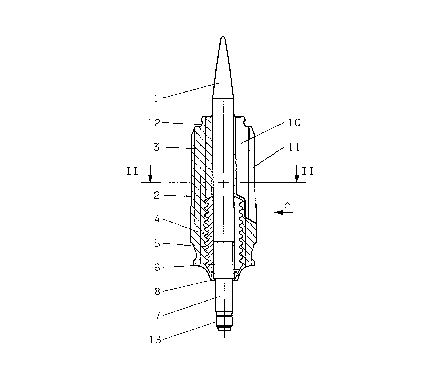Une partie des informations de ce site Web a été fournie par des sources externes. Le gouvernement du Canada n'assume aucune responsabilité concernant la précision, l'actualité ou la fiabilité des informations fournies par les sources externes. Les utilisateurs qui désirent employer cette information devraient consulter directement la source des informations. Le contenu fourni par les sources externes n'est pas assujetti aux exigences sur les langues officielles, la protection des renseignements personnels et l'accessibilité.
L'apparition de différences dans le texte et l'image des Revendications et de l'Abrégé dépend du moment auquel le document est publié. Les textes des Revendications et de l'Abrégé sont affichés :
| (12) Brevet: | (11) CA 2215295 |
|---|---|
| (54) Titre français: | SABOT DE PROJECTILE SOUS-CALIBRE |
| (54) Titre anglais: | SABOT FOR A SUBCALIBER PROJECTILE |
| Statut: | Périmé et au-delà du délai pour l’annulation |
| (51) Classification internationale des brevets (CIB): |
|
|---|---|
| (72) Inventeurs : |
|
| (73) Titulaires : |
|
| (71) Demandeurs : |
|
| (74) Agent: | MACRAE & CO. |
| (74) Co-agent: | |
| (45) Délivré: | 2000-08-22 |
| (22) Date de dépôt: | 1997-09-11 |
| (41) Mise à la disponibilité du public: | 1998-07-27 |
| Requête d'examen: | 1997-09-11 |
| Licence disponible: | S.O. |
| Cédé au domaine public: | S.O. |
| (25) Langue des documents déposés: | Anglais |
| Traité de coopération en matière de brevets (PCT): | Non |
|---|
| (30) Données de priorité de la demande: | ||||||
|---|---|---|---|---|---|---|
|
Sabot permettant d'obtenir un joint optimal de retenue du gaz et de diminuer le poids et le risque que présente la formation d'éclats de métal. A cette fin, le corps du sabot (4) est totalement entouré d'une douille de sabot (3) qui recouvre en partie l'arrière du projectile (1). Le corps du sabot (4) a la forme d'un corps creux constitué d'une ou de plusieurs pièces; il est muni de rainures sur sa circonférence (5, 34) et a un diamètre extérieur qui est inférieur à celui de la douille du sabot. (Fig. 1)
This sabot results in an optimal gas seal and reduction
in the weight and the risk posed by the formation of metal
splinters. For this purpose, the sabot body (4) is completely
enclosed by the sabot casing (3) which partly also encloses
the rear of the pointed projectile (1). The sabot body (4)
has the shape of a one-part or multiple-part hollow body with
circumferential grooves (5, 34), and an exterior diameter
which is smaller than the diameter of the sabot casing.
(Fig. 1)
Note : Les revendications sont présentées dans la langue officielle dans laquelle elles ont été soumises.
Note : Les descriptions sont présentées dans la langue officielle dans laquelle elles ont été soumises.

2024-08-01 : Dans le cadre de la transition vers les Brevets de nouvelle génération (BNG), la base de données sur les brevets canadiens (BDBC) contient désormais un Historique d'événement plus détaillé, qui reproduit le Journal des événements de notre nouvelle solution interne.
Veuillez noter que les événements débutant par « Inactive : » se réfèrent à des événements qui ne sont plus utilisés dans notre nouvelle solution interne.
Pour une meilleure compréhension de l'état de la demande ou brevet qui figure sur cette page, la rubrique Mise en garde , et les descriptions de Brevet , Historique d'événement , Taxes périodiques et Historique des paiements devraient être consultées.
| Description | Date |
|---|---|
| Le délai pour l'annulation est expiré | 2017-09-11 |
| Lettre envoyée | 2016-09-12 |
| Accordé par délivrance | 2000-08-22 |
| Inactive : Page couverture publiée | 2000-08-21 |
| Inactive : Taxe finale reçue | 2000-05-18 |
| Préoctroi | 2000-05-18 |
| Un avis d'acceptation est envoyé | 2000-04-20 |
| Lettre envoyée | 2000-04-20 |
| month | 2000-04-20 |
| Un avis d'acceptation est envoyé | 2000-04-20 |
| Inactive : Approuvée aux fins d'acceptation (AFA) | 2000-04-03 |
| Modification reçue - modification volontaire | 2000-01-07 |
| Inactive : Dem. de l'examinateur par.30(2) Règles | 1999-08-11 |
| Demande publiée (accessible au public) | 1998-07-27 |
| Inactive : CIB attribuée | 1998-01-20 |
| Symbole de classement modifié | 1998-01-20 |
| Inactive : CIB en 1re position | 1998-01-20 |
| Inactive : Certificat de dépôt - RE (Anglais) | 1997-11-17 |
| Lettre envoyée | 1997-11-17 |
| Demande reçue - nationale ordinaire | 1997-11-17 |
| Exigences pour une requête d'examen - jugée conforme | 1997-09-11 |
| Toutes les exigences pour l'examen - jugée conforme | 1997-09-11 |
Il n'y a pas d'historique d'abandonnement
Le dernier paiement a été reçu le 1999-08-17
Avis : Si le paiement en totalité n'a pas été reçu au plus tard à la date indiquée, une taxe supplémentaire peut être imposée, soit une des taxes suivantes :
Les taxes sur les brevets sont ajustées au 1er janvier de chaque année. Les montants ci-dessus sont les montants actuels s'ils sont reçus au plus tard le 31 décembre de l'année en cours.
Veuillez vous référer à la page web des
taxes sur les brevets
de l'OPIC pour voir tous les montants actuels des taxes.
Les titulaires actuels et antérieures au dossier sont affichés en ordre alphabétique.
| Titulaires actuels au dossier |
|---|
| OERLIKON-CONTRAVES PYROTEC AG |
| Titulaires antérieures au dossier |
|---|
| RUDOLF ROSSMANN |